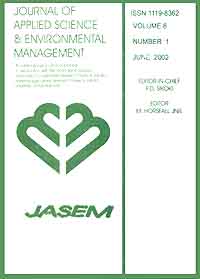
|
Journal of Applied Sciences and Environmental Management
World Bank assisted National Agricultural Research Project (NARP) - University of Port Harcourt
ISSN: 1119-8362
Vol. 6, No. 2, 2002, pp. 89-95
|
 Bioline Code: ja02036
Bioline Code: ja02036
Full paper language: English
Document type: Research Article
Document available free of charge
|
|
|
Journal of Applied Sciences and Environmental Management, Vol. 6, No. 2, 2002, pp. 89-95
| en |
Studies on the Use of Agricultural By-Product for the Removal of Trace Metals from Aqueous Solutions
ABIA, A. A; HORSFALL, M Jnr; DIDI, O
Abstract
The use of pure activated and differentially thiolated cassava waste biomass as adsorbents for the removal of metal ions such as cadmium, copper, and zinc in aqueous solutions were studied by means of equilibrium sorption. The sorption rates of the three metals are 0.2303 min-1 (Cd2+), 0.0051 min-1 (Cu2+) and 0.0040 min-1 (Zn2+) for 0.5M thiolation level and 0.109 min-1 (Cd2+), 0.0069 min-1 (Cu2+) and 0.0367 min-1 (Zn2+) for 1.00M thiolation level respectively. The adsorption rates are quite rapid and within 60 minutes of mixing about 60 - 80 percent of these ions were removed from the solutions by the biomass. The results further showed that increased thiolation led to increased incorporation or availability of more binding groups into the cellulosic matrix, resulting in improved adsorptivity of the cassava waste biomass. The binding capacity study showed that the cassava waste, which is hitherto a serious environmental nuisance due to the fouling odour, released during decomposition has the ability to adsorb trace metals from solutions. @JASEM
|
| |
© Copyright 2002 - Journal of Applied Sciences & Environmental Management
|
|
